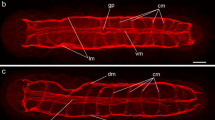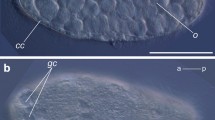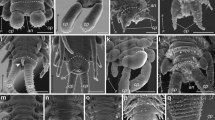Abstract
The systematic position of Polygordiidae is still under debate. They have been assigned to various positions among the polychaetes. Recent molecular analyses indicate that they might well be part of a basal radiation in Annelida, suggesting that certain morphological characters could represent primitive character traits adopted from the annelid stem species. To test this hypothesis, an investigation of the muscular and nervous systems by means of immunological staining and confocal laser scanning microscopy and transmission electron microscopy was conducted. With the exception of the brain, the nervous system is entirely basiepidermal and consists of the brain, the esophageal connectives, the subesophageal region, the ventral nerve cord and several smaller longitudinal nerves. These are connected by a considerable number of ring nerves in each segment. The ventral nerve cord is made up of closely apposed longitudinal neurite bundles, a median and two larger lateral ones. Since distinct ganglia are lacking, it represents a medullary cord. The muscular system mainly consists of longitudinal fibers, regularly distributed oblique muscles and strong septa. The longitudinal fibers form a right and a left unit separated along the dorsal midline, each divided into a dorsal and ventral part by the oblique muscles. Anteriorly, the longitudinal musculature passes the brain and terminates in the prostomium. There is no musculature in the palps. In contrast to earlier observations, regularly arranged minute circular muscle fibers are present. Very likely, a basiepithelial and non-ganglionic organization of the ventral nerve cord as well as an orthogonal nervous system represent plesiomorphic characters. The same applies for the predominance of longitudinal muscle fibers.








Similar content being viewed by others
Explore related subjects
Discover the latest articles and news from researchers in related subjects, suggested using machine learning.References
Bergter A, Brubacher JL, Paululat A (2008) Muscle formation during embryogenesis of the polychaete Ophryotrocha diadema (Dorvilleidae)—new insights into annelid muscle patterns. Front Zool 5(1):1–18
Bullock TH, Horridge GA (1965) Structure and function in the nervous system of invertebrates. Freeman & Co., New York, San Francisco, pp 1–798
Clark RB (1981) Locomotion and the phylogeny of the Metazoa. Boll Zool 48:11–28
Coulon J, Bessone R (1979) Autoradiographic detection of indolamine and catecholamine neurons in the nervous system of Owenia fusiformis (Polychaeta, Annelida). Cell Tiss Res 198:95–104
Dales RP (1963) Annelids. Hutchinson & Co, London, pp 1–200
Ermak TH, Eakin RM (1976) Fine structure of the cerebral and pygidial ocelli in Chone ecaudata (Polychaeta: Sabellidae). J Ultrastruct Res 54:243–260
Faller S, Rothe BH, Todt C, Schmidt-Rhaesa A, Loesel R (2012) Comparative neuroanatomy of Caudofoveata, Solenogastres, Polyplacophora, and Scaphopoda (Mollusca) and its phylogenetic implications. Zoomorphology 131:149–170
Fauchald K (1977) The polychaete worms. Definitions and keys to the orders, families and genera. Nat Hist Mus Los Angel Cty Sci Ser 28:1–188
Filippova A, Purschke G, Tzetlin AB, Müller MCM (2005) Reconstruction of the musculature of Magelona cf. mirabilis (Magelonidae) and Prionospio cirrifera (Spionidae) (Polychaeta; Annelida) by phalloidin labelling and cLSM. Zoomorphology 124:1–8
Filippova A, Purschke G, Tzetlin AB, Müller MCM (2006) Three-dimensional reconstruction of the F-actin musculature of Dorvillea kastjani (Dorvilleidae: Polychaeta) by means of phalloidin-labelling and cLSM. Sci Mar 70(S3):293–300
Filippova A, Purschke G, Tzetlin AB, Müller MCM (2010) Musculature in polychaetes: comparison of Myrianida prolifera (Syllidae) and Sphaerodoropsis sp. (Sphaerodoridae). Invertebr Biol 129:184–198
Fraipont J (1887) Le genre Polygordius. Fauna Flora Golf Neapel 14:1–125
Fransen ME (1980) Ultrastructure of coelomic organization in annelids I. Archiannelids and other small polychaetes. Zoomorphology 95:235–249
Gardiner SL (1992) General organization, integument, musculature, coelom and vascular system. In: Harrison FW, Gardiner SL (eds) Microscopic anatomy of invertebrates, vol 7. Wiley-Liss, New York, pp 19–52
Giard MA (1880) On the affinities and of the genus Polygordius with the annelids of the family Opheliidae. Ann Mag Nat Hist Ser 5:324–326
Golding DW (1992) Polychaeta: nervous system. In: Harrison FW, Gardiner SL (eds) Microscopic anatomy of invertebrates, vol 7. Wiley-Liss, New York, pp 153–179
Goodrich ES (1901) On the structure and affinities of Saccocirrus. Q J Microsc Sci 44:413–428
Hanström B (1929) Weietre Beiträge zur Kenntnis des Gehirns und der Sinnesorgane der Polychäten (Polygordius, Tomopteris, Scolelepis). Z Morph Ökol Tiere 13:329–358
Hartmann-Schröder G (1958) Zur Morphologie der Opheliiden (Polychaeta Sedentaria). Z Wiss Zool 161:84–143
Harzsch S (2007) The architecture of the nervous system provides important characters for phylogenetic reconstructions: examples from the Arthropoda. Species Phylogeny Evol 1:33–57
Harzsch S, Müller CHG (2007) A new look at the ventral nerve centre of Sagitta: implications for the phylogenetic position of Chaetognatha (arrow worms) and the evolution of the bilaterian nervous system. Front Zool 4(14):1–15
Hatschek B (1878) Studien über die Entwicklungsgeschichte der Anneliden. Arb Zool Inst Wien 6:277–404
Hatschek B (1893) System der Anneliden, ein vorläufiger Bericht. Lotos 13:123–126
Hay-Schmidt A (1995) The larval nervous system of Polygordius lacteus Scheinder [sic], 1868 (Polygordiidae, Polychaeta): Immunocytochemical data. Acta Zool (Stockh) 76:121–140
Hempelmann F (1906) Zur Morphologie von Polygordius lacteus Schn. und Polygordius triestinus Woltereck, nov. spec. Z Wiss Zool 84:527–618
Hermans C (1969a) Fine structure of the segmental ocelli of Armandia brevis (Polychaeta: Opheliidae). Z Zellforsch Mikrosk Anat 96:361–371
Hermans CO (1969b) The systematic position of the Archiannelida. Syst Zool 18:85–102
Hessling R, Purschke G (2000) Immunohistochemical (cLSM) and ultrastructural analysis of the central nervous system and sense organs in Aeolosoma hemprichi (Annelida, Aeolosomatidae). Zoomorphology 120:65–78
Hessling R, Müller MCM, Westheide W (1999) CLSM analysis of serotonin-immunoreactive neurons in the central nervous system of Nais variabilis, Slavinia appendiculata and Stylaria lacustris (Oligochaeta: Naididae). Hydrobiolgia 406:223–233
Jouin C (1970) Recherches sur les Protodrilidae (Archiannélides): I. Étude morphologique et systématique du genre Protodrilus. Cah Biol Mar 11:367–434
Kieneke A, Ostmann A (2012) Structure, function and evolution of somatic musculature in Dasydytidae (Paucitubulatina, Gastrotricha). Zoomorphology 131:95–114
Lanterbecq D, Bleidorn C, Michel S, Eeckhaut I (2008) Locomotion and fine structure of parapodia in Myzostoma cirriferum (Myzostomida). Zoomorphology 127:59–68
Lanzavecchia G, de Eguileor M, Valvassori R (1988) Muscles. In: Westheide W, Hermans CO (eds) The ultrastructure of Polychaeta. Microfauna Marina 4: Fischer, Stuttgart, pp 71–88
Leasi F, Neves RC, Worsaae K, Sørensen MV (2012) Musculature of Seison nebaliae Grube, 1861 and Paraseison annulatus (Claus, 1876) revealed with CLSM: a comparative study of the gnathiferan key taxon Seisonacea (Rotifera). Zoomorphology 131:185–195
Liesenjohann T, Neuhaus B, Schmidt-Rhaesa A (2006) Head sensory organs of Dactylopodola baltica (Macrodasyida, Gastrotricha): a combination of transmission electron microscopical and immunocytochemical techniques. J Morphol 267:897–908
Martin N, Anctil M (1984) The nervous system of the tube-worm Chaetopterus variopedatus (Polychaeta). J Morphol 181:161–173
Mettam C (1967) Segmental musculature and parapodial movement of Nereis diversicolor and Nephthys hombergi (Annelida: Polychaeta). J Zool Lond 153:245–275
Mettam C (1971) Functional design and evolution of the polychaete Aphrodite aculeata. J Zool Lond 163:489–514
Mettam C (1985) Functional constraints in the evolution of the Annelida. In: Conway Morris S, George JD, Gibson R, Platt HM (eds) The origins and relationships of lower invertebrates. Clarendon, Oxford, pp 297–309
Müller MCM (2006) Polychaete nervous systems: ground pattern and variations—cLS microscopy and the importance of novel characteristics in phylogenetic analysis. Integr Comp Biol 46:125–133
Müller MC, Westheide W (2000) Structure of the nervous system of Myzostoma cirriferum (Annelida) as revealed by immunohistochemistry and cLSM analyses. J Morphol 245:87–98
Müller MCM, Westheide W (2002) Comparative analysis of the nervous system in presumptive progenetic dinophilid and dorvilleid polychaetes (Annelida) by immunohistochemistry and cLSM. Acta Zool (Stockh) 83:33–48
Müller MCM, Worsaae K (2006) CLSM analysis of the phalloidin stained muscle system in Nerilla antennata, Nerillidium sp. and Trochonerilla mobilis (Polychaeta; Nerillidae). J Morphol 267:885–896
Orrhage L (1974) Über die Anatomie, Histologie und Verwandtschaft der Apistobranchidae (Polychaeta, Sedentaria) nebst Bemerkungen über die systematische Stellung der Archianneliden. Z Morph Tiere 79:1–45
Orrhage L, Müller MCM (2005) Morphology of the nervous system of Polychaeta (Annelida). Hydrobiologia 535(536):79–111
Paul C, Halanych KM, Tiedemann R, Bleidorn C (2010) Molecules reject an opheliid affinity for Travisia (Annelida). Syst Biodivers 8:507–512
Pierantoni U (1908) Protodrilus. Fauna Flora Golf Neapel 31:1–226
Pilato G (1981) The significance of musculature in the origin of the Annelida. Boll Zool 48:209–228
Purschke G (1993) Structure of the prostomial appendages and the central nervous system in the Protodrilida (Polychaeta). Zoomorphology 113:1–20
Purschke G (2002) On the ground pattern of Annelida. Org Divers Evol 2:181–196
Purschke G, Müller MCM (2006) Evolution of body wall musculature. Integr Comp Biol 46:497–507
Ramey PA (2008) Life history and population dynamics of a dominant polychaete, Polygordius jouinae, in inner continental shelf sands of the Mid-Atlantic Bight, USA. Mar Biol 154:443–452
Ramey PA, Fiege D, Purschke G (2013) 8.5. Polygordiida: Polygordiidae Czerniavsky, 1881. In: Westheide W, Purschke G (eds) Handbook of zoology. De Gruyter, Berlin (published online ahead of print as Zoology Online) pp 1–10
Richter S, Loesel R, Purschke G, Schmidt-Rhaesa A, Scholtz G, Stach T, Vogt L, Wanninger A, Brenneis G, Döring C, Faller S, Fritsch M, Grobe P, Heuer CM, Kaul S, Moller OS, Müller CHG, Riede V, Rothe BH, Stegener MEJ, Harzsch S (2010) Invertebrate neurophylogeny: suggested terms and definitions for a neuroanatomical glossary. Front Zool 7(29):1–49
Rieger RM (1980) A new group of interstitial worms, Lobatocerebridae nov. fam. (Annelida) and its significance for metazoan phylogeny. Zoomorphology 95:41–84
Rota E, Carchini G (1999) A new Polygordius (Annelida: Polychaeta) from Terra Nova Bay, Ross Sea, Antarctica. Polar Biol 21:201–213
Rothe BH, Schmidt-Rhaesa A, Kieneke A (2011) The nervous system of Neodasys chaetonotoideus (Gatsrotricha: Neodasys) revealed by combining confocal laser scanning and transmission electron microscopy: evolutionary comparison of neuroanatomy within the Gastrotricha and basal Protostomia. Zoomorphology 130:51–84
Rouse GW (2001) In: Rouse GW, Pleijel F (eds) 71. Polygordiidae Czerniavsky, 1881a. Oxford University Press, Oxford, pp 279–281
Rouse GW, Fauchald K (1995) The articulation of annelids. Zool Scr 24:269–301
Rouse GW, Fauchald K (1997) Cladistics and polychaetes. Zool Scr 26:139–204
Salensky W (1907) Morphogenetische Studien an Würmern. II. Über die Anatomie der Archianneliden nebst Bemerkungen über den Bau einiger Organe des Saccocirrus papillocercus. Mém Acad Imp Sci St-Petersbourg Ser 8 109: 103–284
Schneider A (1868) Über Bau und Entwickelung von Polygordius. Arch Anat Physiol Wiss Med Leipzig 10:51–60
Storch V (1968) Zur vergleichenden Anatomie der segmentalen Muskelsysteme und zur Verwandtschaft der Polychaeten-Familien. Z Morph Tiere 63:251–342
Struck TH (2011) Direction of evolution within Annelida and the definition of Pleistoannelida. J Zool Syst Evol Res 49:340–345
Struck TH, Purschke G (2005) The sister group relationship of Aeolosomatidae and Potamodrilidae (Annelida: “Polychaeta”)—a molecular phylogenetic approach based on 18S rDNA and cytochrome oxidase I. Zool Anz 243:281–293
Struck TH, Westheide W, Purschke G (2002) Progenesis in Eunicida (“Polychaeta”, Annelida)—separate evolutionary events? Mol Phylogenet Evol 25:190–199
Struck TH, Nesnidal M, Purschke G, Halanych KM (2008) Detecting possible saturated positions in 18 S and 28 S sequences and their influence on phylogenetic reconstruction of Annelida (Lophotrochozoa). Mol Phylogenet Evol 48:628–645
Struck TH, Paul C, Hill N, Hartmann S, Hösel C, Kube M, Lieb B, Meyer A, Tiedemann R, Purschke G, Bleidorn C (2011) Phylogenomic analyses unravel annelid evolution. Nature 471:95–98
Tzetlin AB, Filippova A (2005) Muscular system in polychaetes (Annelida). Hydrobiologia 535(536):113–126
Tzetlin AB, Zhadan A, Ivanov I, Müller MCM, Purschke G (2002a) On the absence of circular muscle elements in the body wall of Dysponetus pygmaeus (Chrysopetalidae, “Polychaeta”, Annelida). Acta Zool (Stockh) 83:81–85
Tzetlin AB, Zhadan A, Ivanov I, Müller MCM, Purschke G (2002b) Ultrastructure of the body wall, body cavity, nephridia and spermatozoa in four species of the Chrysopetalidae (Annelida, ‘Polychaeta’). Zool Anz 241:37–55
Wanninger A, Koop D, Bromham L, Noonan E, Degnan BM (2005) Nervous and muscle system development in Phascolion strombus (Sipuncula). Dev Genes Evol 215:509–518
Wanninger A, Fuchs J, Haszprunar G (2007) Anatomy of the serotonergic nervous system of an ectoproct creeping-type larva and its phylogenetic implications. Invertebr Biol 126:268–278
Wells BGP (1950) The anatomy of the body wall and appendages in Arenicola marina L., Arenicola claparedii Levinsen and Arenicola ecaudata Johnston. J Mar Biol Assoc UK 29:1–44
Westheide W (1985) The systematic position of the Dinophilidae and the archiannelid concept. In: George D, Gibson R, Platt HM (eds) The origin and relationships of lower invertebrates. Oxford University, Oxford, pp 310–326
Westheide W (1987) Progenesis as a principle in meiofauna evolution. J Nat Hist 21:843–854
Wilkens V, Purschke G (2009) Central nervous system and sense organs, with special reference to photoreceptor-like sensory elements, in Polygordius appendiculatus (Annelida), an interstitial annelid with uncertain phylogenetic affinities. Invertebr Biol 128:46–64
Worsaae K, Kristensen RM (2005) Evolution of interstitial polychaetes. Hydrobiologia 535(536):319–340
Worsaae K, Rouse GW (2008) Is Diurodrilus an annelid? J Morphol 269:1425–1456
Zantke J, Wolff C, Scholtz G (2008) Three-dimensional reconstruction of the central nervous system of Macrobiotus hufelandi (Eutardigrada, Parachela): implications for the phylogenetic position of Tardigrada. Zoomorphology 127:21–36
Zrzavy J, Riha P, Pialek L, Janouskovec J (2009) Phylogeny of Annelida (Lophotrochozoa): total-evidence analysis of morphology and six genes. BMC Evol Biol 9:189
Acknowledgments
A grant from the German Science Foundation (DFG; Grant Number FI 433/10-1) supporting this study is gratefully acknowledged. We express our thanks to Dr. Patricia Ramey-Balci and the staff of the Biologische Anstalt Helgoland and the Station Biologique de Roscoff for various kinds of help. We thank Professor Achim Paululat, Osnabrück, for continuous support and discussions.
Author information
Authors and Affiliations
Corresponding author
Additional information
Communicated by A. Schmidt-Rhaesa.
We would like to dedicate this article to the outstanding morphologist, phylogeneticist and academic teacher Professor Dr. Peter Ax—inter alia editor-in-chief of this journal for many years—who passed away at the age of 86 on May 2, 2013.
Rights and permissions
About this article
Cite this article
Lehmacher, C., Fiege, D. & Purschke, G. Immunohistochemical and ultrastructural analysis of the muscular and nervous systems in the interstitial polychaete Polygordius appendiculatus (Annelida). Zoomorphology 133, 21–41 (2014). https://doi.org/10.1007/s00435-013-0203-6
Received:
Revised:
Accepted:
Published:
Issue Date:
DOI: https://doi.org/10.1007/s00435-013-0203-6




